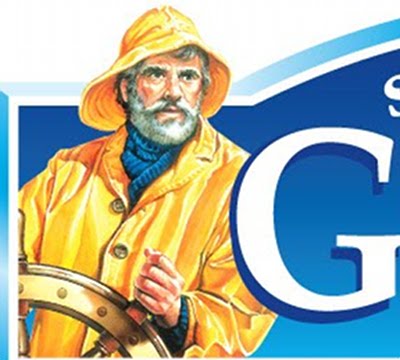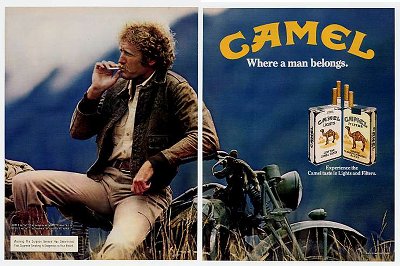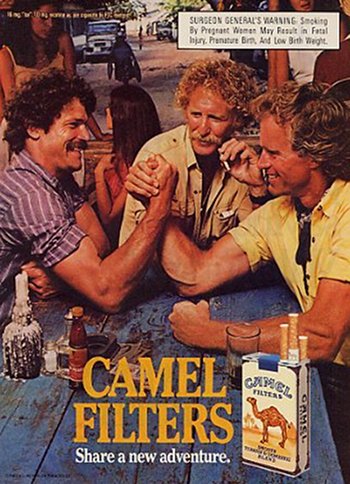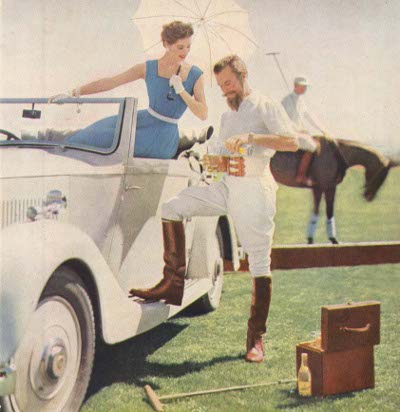
For over a century, companies have used masculinity and manliness (or idealized versions of it) to sell their wares to both men and women. When selling to women, advertisers hope to lure the fairer sex into opening their pocketbooks by using masculinity to symbolize the strength of their products or by associating their brands with virile sex appeal. Remember that Diet Coke commercial from the 90s? The one with the gals taking a “Diet Coke break” to scope out some brawny, good looking, and shirtless construction worker from their office window? Perfect example of using a masculine image to sell to women.
When men are the target audience, advertisers often take a different approach. They infuse a brand with aspirational imagery and attempt to convey the message of “If you buy this product, then you’ll obtain the pinnacle of manliness. Women will want you and men will want to be you.” So we see commercials showcasing successful, rugged, and debonaire dudes pitching products to men who are looking for some simple talisman that will magically imbue them with the manliness they feel they lack.
For the past 100 years, Madison Avenue has rolled out dozens upon dozens of brand icons that were designed to evoke this feeling of supreme manliness in consumers. Most of these brand mascots slip into the abyss of history, forever forgotten.
But a few transcend merely selling products. They become cultural icons that both influence (for better or for worse) what manliness means in our culture, while also holding a mirror to the culture’s ideals of manliness at a given time. From dapper dudes who evoked the desire to be sophisticated and upper-class to rugged men who symbolized a virility feared to be long lost, to our modern day, when advertisers rarely feel comfortable using masculinity in a earnest way and invariably present it with wink-wink irony.
Of course, smart men have always known that manliness can’t be bought, but even when advertisers don’t convince you to spend money, the best ads can simply be enjoyed as examples of effective, fun, and creative storytelling.
With that attitude, today we take a look at 11 of the most famous and manly brand icons ever created.
Dos Equis Most Interesting Man in the World
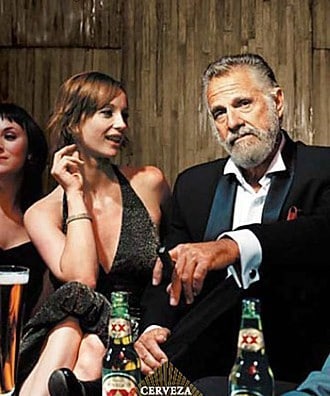
The Dos Equis Most Interesting Man in the World has become an a cult hero since the launch of this campaign back in 2006. He’s an older, bearded man, with leathery suntanned skin, and a handsome Spanish accent who takes part in adventurous and manly pursuits like Acapulco cliff diving, jai alai, and falconry.
The commercials mix together grainy, vintage footage showcasing the Most Interesting Man’s manly feats while a narrator describes our Man’s over-the-top exploits. The copy on these commercials is some of the best and most clever in ad history:
- His words carry weight that would break a less interesting man’s jaw.
- He can speak French, in Russian.
- When in Rome, they do as he does.
- His blood smells like cologne.
- His mother has a tattoo that reads “son.”
- He once punched a magician. That’s right, you heard me.
If you haven’t seen the commercials, here’s an example:
If you want to see all of the Most Interesting Man in the World commercials in one place, go here.
The Arrow Collar Man
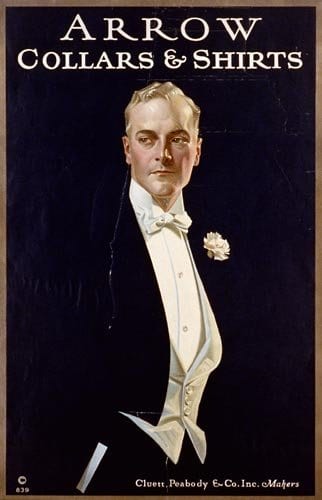
If you were a man living in the early part of 20th century America, you probably knew who the Arrow Collar Man was. Created in 1905, the Arrow Collar Man was the name given to various male models who appeared in magazine and billboard advertisements for Arrow collars and shirts. Illustrator J.C. Leyendecker was the artist behind the ads. His unique artistic style gave the Arrow Collar Man a very angular, modern, and American look. The men always had very squared-off, masculine jaw lines with perfectly coiffed hair. The ads were designed to create a feeling of success, sophistication, and masculine virility in customers.
From 1905 to 1931, the Arrow Collar Man was an American cultural icon. President Theodore Roosevelt said that the Arrow Man was “a superb portrait of the common man.” Women wrote this fictional character love letters by the thousands each week and a few even proposed marriage to him.
The Arrow Man campaign was a huge success. Whenever an ad came out featuring the Arrow Man wearing a new collar, men would be lined up outside of clothing stores to get their hands on the product. By the 1920s, Arrow was selling 4 million collars a week.
The campaign ended in 1931 and is hailed by many advertisers as one of the most successful ad campaigns in history.
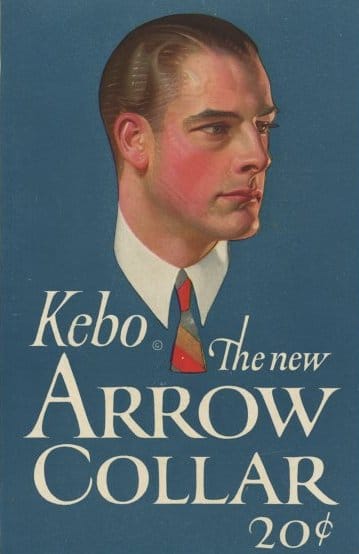
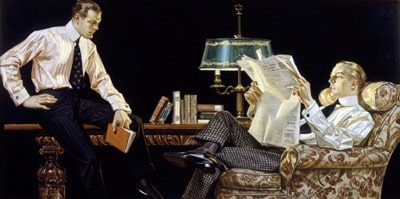
The Marlboro Man
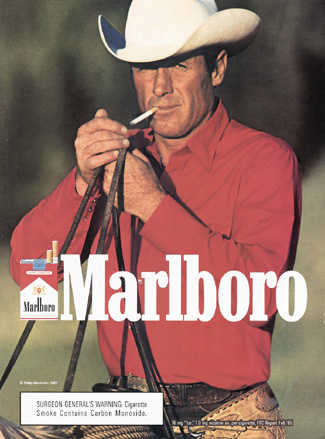
The Marlboro Man is assuredly the most successful and most controversial manly brand icon on the list. Created in 1954 by advertiser Leo Burnett, the Marlboro Man was a lone, rugged cowboy who always had a Marlboro cigarette coolly dangling from his lips.
The story of why the Marlboro Man was created is pretty fascinating. Marlboro cigarettes were some of the first in the U.S. to feature filters. But back in the 50s, filtered cigarettes (and particularly Marlboros) were considered a chick’s cigarette. So to increase sales among men, the Marlboro Man was born. In a few short months after the Marlboro Man campaign started, the womanly aura around filtered cigarettes had successfully been replaced with a manlier one, and sales increased.
The first Marlboro Men were actors dressed up like cowboys, but ad man Burnett thought they lacked authenticity. So he began a search for a real cowboy who could play the Marlboro Man. They found their man in Wyoming rancher, Darrell Winfield. Winfield played the iconic brand spokesman from 1968 to 1989.
During his heyday, the Marlboro Man could be found everywhere–from the pages of popular men’s magazines to a giant billboard in Times Square. But during the late 80s and 90s, the Marlboro Man suffered a one-two punch that resulted in his quick decline. The first blow came from the deaths of three former actors who took part in the Marlboro Man ad campaigns. All three men died from lung cancer, a disease caused by smoking. Their deaths garnered a great deal of negative publicity for the Marlboro Man, the Marlboro brand, and the cigarette industry as a whole.
The second blow came from anti-tobacco litigation, which resulted in limits being placed on cigarette advertising in magazines and on radio, television, and billboards. Because of the negative press surrounding the Marlboro Man and tobacco in general, Philip Morris discontinued the campaign in 1999.
Despite being laid to rest with other brand icons, the Marlboro Man still lives on in pop culture and continues to influence the way masculinity is portrayed in America.
Mr. Clean
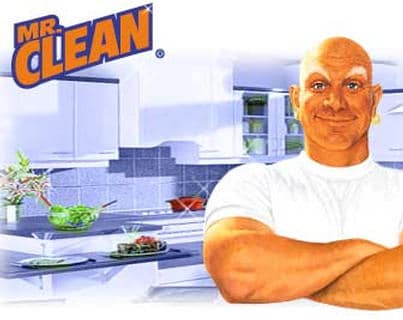
Mr. Clean isn’t a genie.
Yes, I know. The bald head, single earring, knowing smile, and folded arms are all clear genie-indicators. But the reality is that Mr. Clean is just supposed to be a badass looking dude who likes to keep things tidy. In 1958, Proctor and Gamble introduced a new home cleaner they dubbed Mr. Clean and created one of the most iconic brand icons in history. P&G wanted a strong, manly looking guy to be the face of their product in order to first, appeal to the ladies who would be buying the product, and second, to convey the message that Mr. Clean is there to kick dirt’s butt.
The original model for Mr. Clean was a retired Navy Sailor living in Florida. For most of his advertising life, Mr. Clean has been an illustration or animated cartoon. Back in the 60s P&G experimented with a live actor named House Peters, Jr. to play Mr. Clean, but it really didn’t work, so it was back to the cartoon.
Adding to his manly persona, Mr. Clean has hardly ever spoken. He’s the strong silent type. He only spoke once in one of those 1960s commercials. If he could speak, he would say, “How am I going to find time to get to the gym with all this damn cleaning I have to do?”
The Man in the Hathaway Shirt

Founded in 1837, C.F. Hathaway was a little known men’s dress shirt company in Waterville, Maine. The company’s only claim to fame up until 1951 was their wartime contract with the Union army to supply uniforms for soldiers. But Hathaway shirts catapulted to success with the introduction of a debonair, silver-haired, eye-patch wearing brand icon simply called “The Man in the Hathaway Shirt.”
Created by famous ad man David Ogilvy, The Man in the Hathaway Shirt campaign ran in magazines in the early 1950s. It consisted of a photo of the hero standing gallantly in some sophisticated locale wearing a well-pressed Hathaway shirt. Underneath was a bit of text talking about his romantic life.
The first ad ran in the New Yorker in 1951 and was an instant success. By the end of the week Hathaway was out of stock on their shirts.
The key to the success of this ad was the eye-patch. It created a bit of mystery and manly intrigue about the character. What happened to him? Did he lose it during a safari? A sabre duel?
The model who portrayed the Hathaway Shirt Man was Baron George Wrangle, a Russian aristocrat who had 20/20 vision and no actual need for an eye patch. Ogilvy said he got the idea for the patch from a photo of Ambassador Lewis Douglas, who injured his eye while fishing in England.
The Man in the Hathaway shirt became a pop culture phenomenon, and his iconic eye patch was “borrowed” by other brands. It was common to see ads with babies, women, and even cows wearing an eye patch. AdAge declared the Man in the Hathaway Shirt campaign to be #22 on the list of top 100 ad campaigns in American history. His influence can still be seen today in Dos Equis’ Most Interesting Man in the World campaign.
Old Spice Man Your Man Can Smell Like
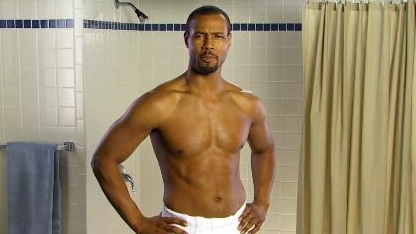
After years of being known as the favorite after-shave of grandpas, Old Spice breathed new life into their nearly eighty-year-old brand with their Man Your Man Can Smell Like campaign. Played by actor Isaiah Mustafa, the Man Your Man Can Smell Like is a sort of smug, but super cool guy who’s on a mission to tell women that “anything is possible” if they buy their men Old Spice body wash.
The TV commercial showcased some creative filmmaking. Filmed with just one single, continuous shot, the Man Your Man Can Smell Like starts in a bathroom and shifts scenes only to end up on a horse at the end. The result was a funny, and surprising bit of advertising:
Because of the success of the Old Spice campaign, other men’s grooming brands have copied gotten inspiration from the Man Your Man Can Smell Like commercials and introduced their own cheeky, smooth, and smug spokesmen–see here and here. It makes one wonder if there is a real shortage of creativity at these creative agencies. I guess they figure that the more over-the-top the manliness of their spokesmen, the less people will notice the fact that they’re pitching dudes an anti-wrinkle and firming cream.
The Old Spice commercials have also created several spoofs, like this well done one from BYU’s library.
Commander Whitehead: The Schweppes Man
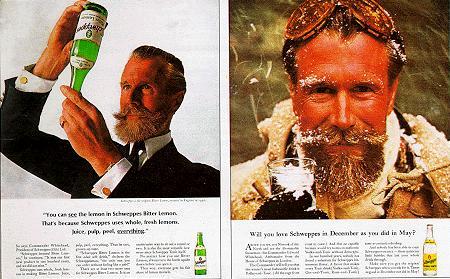
Tonic water. It’s not the most glamorous thing in the world, but with the right spokesman you can turn it into a product that aspiring gentleman all over the world want to buy. In 1955 Schweppes turned to advertising genius David Ogilvy to create a campaign for their tonic water. Instead of creating a fictional character to be the face of Schweppes, Ogilvy used Commander Edward Whitehead, an executive of Schweppes who came to the U.S. to oversee American distribution of Schweppes tonic water.
Whitehead was the perfect face to create an air of manly sophistication around the Schweppes brand. The ads played up the fact that Whitehead was a real commander in the Royal Navy during World War II. And of course his amazing beard got plenty of camera time. The ads showed Commander Whitehead taking part in various manly activities that Whitehead actually enjoyed in real life. Some showed him mountain climbing or arctic exploring, while others featured him in more sophisticated settings like a dinner party with beautiful women. Commander Whitehead was the man every man wished he could be.
The Commander Whitehead campaign ran from the 1950s though the 1960s.
You can tell the folks in charge of the Dos Equis Most Interesting Man in the World campaign took a lot of inspiration from Commander Whitehead. The distinguished gray beard, the sophisticated yet manly persona. It’s all there.
The Gorton’s Fisherman
What better way to sell frozen fish sticks than to use an image of a manly looking fisherman? The Gorton Fish Company has been around since before the War Between the States, but it wasn’t until 1964 that they introduced the Gorton Fisherman as the face of their frozen fish products. Gray bearded (anybody else seeing a trend among these ad icons?) and clad in a yellow slicker, the Gorton Fisherman looks ahead with steely resolve as he guides his ship to waters filled with beer battered fish. In 1978, the company gave the Gorton Fisherman more gravitas by adding the tagline “Trust the Gorton’s Fisherman,” to their products. Yes, Gorton’s Fisherman, we will trust you. Trust you to elicit groans from children when you are removed from the freezer.
The Camel Where a Man Belongs Man
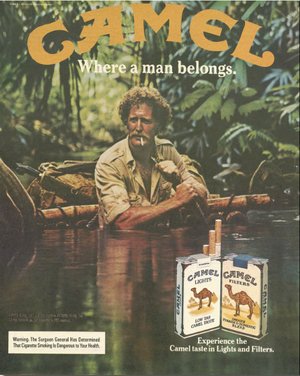
Before Joe Camel was secretly hawking cigarettes to kids, the R.J. Reynolds Company created a rugged, manly man to be the face of Camel cigarettes. The ad campaign was called “Where a Man Belongs.” It featured a brawny, mustached man with an awesome 1970s white dude afro doing awesomely manly things like fording a river in a rain forest, safariing in Africa, riding his motorcycle across the country, and watching an arm wrestling match.
The campaign ran in magazines during the late 70s and early 80s, and it had some success. When sales started to slump, Camel ditched the Where a Man Belongs Man for a cartoon camel whose nose looked an awful like a giant wiener. The switch must have worked because Camel sales picked up with Mr. Joe Camel.
John Jameson

Jameson Irish Whiskey has been around since 1780. Founded by John Jameson in Dublin, Ireland, the whiskey became an international favorite by 1805.
Fast forward 200 years and the company is working hard to keep their brand relevant. You may have seen the recent Jameson Irish Whiskey commercials where John Jameson jumps into the ocean to save a barrel of his beloved Irish whiskey, battles a giant squid, and shows up at his own funeral along with all of Ireland. It’s one of my favorite commercials. I’ll always stop to watch it. It’s fun and tells a great story in under 30 seconds. Advertising at its finest.
The commercial, while exaggerated, is actually based (somewhat) in fact, according to The New York Times. First, John Jameson was a real dude. We established that. Second, while it can’t be ascertained that he sailed the world in the ship Mary to bring the world his whiskey, there is a ship called Mary that is a part of Jameson’s family history. Family diaries mention a family ship that battled pirates on the high seas, and it also appears on a Jameson family crest. Finally, the lost barrel story highlighted in the commercial is supposedly based on a true story according to the official Jameson site.
If you haven’t seen the commercial, watch it:
The Brawny Man

What do you do when you want to convey that your paper towel has the strength to tackle any kitchen mess? You create one of the manliest brand icons ever in the history of advertising, that’s what.
The Brawny Man has been the face of Georgia-Pacific’s paper towels since Richard Nixon resigned as President (1974, for you youngins who might not know). The Brawny Man’s masculine image comes straight out of the decade in which he was spawned–long shaggy hair, mustache, and unbuttoned shirt to show off his manly chest hair. This masculine and virile image created a score of 70% of “unaided brand awareness” for Brawny paper towels. Meaning, people could just see a picture of the Brawny Man and they’d know that he represented Brawny paper towels.
Despite the success of the Brawny Man, in 2004 Georgia-Pacific decided the Brawny Man needed a style update to convey a kinder, gentler image. First, they made the Brawny Man shave his mustache off (the humanity!). Next, they made him get a haircut. Finally, they made him cover up his glorious chest hair by making him wear an undershirt.
Here’s the Brawny Man post-makeover:
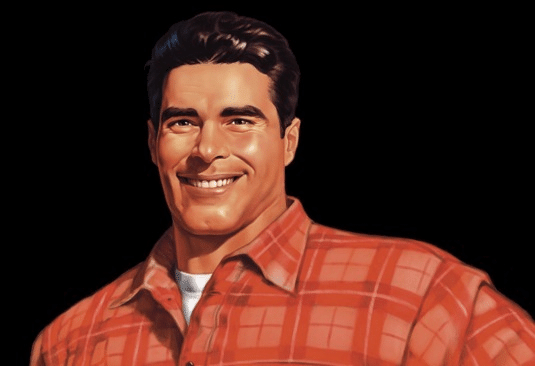
He looks like a cartoon of what’s supposed to be every woman’s fantasy man: clean shaven, barrel chested, and helpful in the kitchen.
Sure, The Brawny Man sort of looked liked a skeevy 70s porn star and probably needed a bit of an update. But come on. Did we have to remove everything manly that made the Brawny Man so awesome? At least let the man keep his mustache. Show your solidarity with the Brawny Man.
What are some other famous manly brand icons? Share them with us in the comments.
***I am continually surprised by the lack of nuance with which people read things and the need for me to make disclaimers like this, but since I have already received complaints from those who misunderstood the post, here we go: this post is meant to be a fun and interesting look at the way advertisers have used masculinity to sell products over the last century. The icons listed are not necessarily being held up as men to emulate. Although if you wanted to clean the kitchen while wearing an eye patch, I bet your wife wouldn’t object. Smoking is bad. Don’t do drugs. Do not attempt to operate machinery while wearing only a towel. I think that covers it.***


